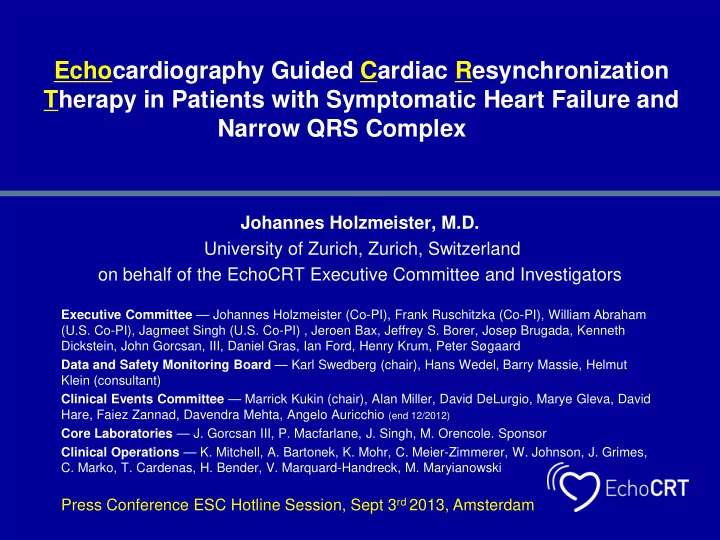

Echocardiography Guided Cardiac Resynchronization Therapy in Patients with Symptomatic Heart Failure and Narrow QRS Complex Johannes Holzmeister, M.D. University of Zurich, Zurich, Switzerland on behalf of the EchoCRT Executive Committee and Investigators Executive Committee — Johannes Holzmeister (Co-PI), Frank Ruschitzka (Co-PI), William Abraham (U.S. Co-PI), Jagmeet Singh (U.S. Co-PI) , Jeroen Bax, Jeffrey S. Borer, Josep Brugada, Kenneth Dickstein, John Gorcsan, III, Daniel Gras, Ian Ford, Henry Krum, Peter Søgaard Data and Safety Monitoring Board — Karl Swedberg (chair), Hans Wedel, Barry Massie, Helmut Klein (consultant) Clinical Events Committee — Marrick Kukin (chair), Alan Miller, David DeLurgio, Marye Gleva, David Hare, Faiez Zannad, Davendra Mehta, Angelo Auricchio (end 12/2012) Core Laboratories — J. Gorcsan III, P. Macfarlane, J. Singh, M. Orencole. Sponsor Clinical Operations — K. Mitchell, A. Bartonek, K. Mohr, C. Meier-Zimmerer, W. Johnson, J. Grimes, C. Marko, T. Cardenas, H. Bender, V. Marquard-Handreck, M. Maryianowski Press Conference ESC Hotline Session, Sept 3 rd 2013, Amsterdam
Declaration of Interest • Consulting Fees from Biotronik as Co-PI of the EchoCRT, • Research Grants from Biotronik • Unlrelated : stock/options of Cardiorentis Ltd., Co-founder, member of the board and consultant of Cardiorentis Ltd.
Why is EchoCRT such an important trial for the treatment of patients with heart failure? Heart failure affects more than 23 million people worldwide. 1,2 With increasing • prevalence 3 and frequent hospitalization it is a major cost to healthcare and patients’ quality of life. 3-5 • We know: cardiac resynchronization therapy (CRT) reduces morbidity and mortality in heart failure (HF) patients with a wide QRS duration. Many heart failure patients with a relatively narrow QRS duration (<130 msec) have mechanical dyssynchrony – a potential target for CRT. • European CRT survey shows a substantial number of heart failure patients received CRT devices with a relatively narrow QRS duration: 6 9% of patients with a normal QRS duration (<120msec) o 10% of patients with a QRS duration of 120-129msec o • Conflicting observational and small randomized trials data created an imperative for a definitive outcome assessment of CRT in heart failure patients with a narrow QRS duration to verify if this life saving therapy extends to narrow QRS. 1. Lloyd-Jones D, et al. American Heart Association. Circulation. 2010; 121: e46–e215. 2. McMurray JJ, Petrie MC, Murdoch DR, Davie AP. Eur Heart J. 1998; 19 (Suppl P): P9–P16. 3. Bui AL, Horwich TB, Fonarow GC. Nat Rev Cardiol. 2011; 8: 30-41. 4. Dunlay S.M., Shah N.D., Shi Q.; Circ Cardiovasc Qual Outcomes . 2011; 4: 68-75. 5. J. Vaccaro, J. Cherry, A. M. Harper, and M. O'Connell, “Disease Management, vol. 4, no. 3, pp. 131–142, 2001. 6. Dickstein K, Bogale N, Priori S, et al. The Eur Heart J (2009) 30 (20): 2450-2460.
Study Objective and Method • To evaluate the effect of CRT on morbidity and mortality when added to optimised pharmacological therapy and an ICD in patients with moderate to severe heart failure due to left ventricular systolic dysfunction (LVEF • 35%) with a narrow QRS complex (QRS < 130 msec) and mechanical dyssynchrony determined by echocardiography. • EchoCRT was an investigator-initiated, prospective, international, multicenter, randomized (1:1 ratio), parallel-group, controlled clinical trial: CRT Group: Atrial-based, biventricular stimulation, DDD 40/min, o standard 2 zone VT/VF LV: from lateral or postero-lateral free wall via the coronary sinus and veins using an any legally marketed lead in the respective country Control Group: DDI/VVI 40/min, standard 2 zone VT/VF o
Results Primary composite endpoint: hospitalization or all-cause mortality occured in 116 of 404 CRT patients versus 102 of 405 control patients (28.7% vs. 25.2%) HR = 1.20 (0.92, 1.57) p=0.15
Sub-group Analyses for Primary Endpoint – Composite
Protocol-specified Cardiovascular Outcomes Risk of Death or Hospitalization for Heart Failure among All Patients Primary and Secondary Outcomes Control CRT Adjusted Hazard Ratio Group Group (95% Confidence Endpoint number (%) number (%) with event with event Interval), p-value (n=405) (n=404) Primary Endpoint Composite Death or WHF hospitalization 102 (25.2%) 116 (28.7%) 1.20 (0.92, 1.57), 0.15 Primary Endpoint Components WHF hospitalization 90 (22.2%) 99 (24.5%) 1.16 (0.87, 1.55), 0.25 All-cause mortality 26 (6.4%) 45 (11.1%) 1.81 (1.11, 2.93), 0.02 Other Cardiovascular Endpoints Cardiovascular hospitalization 137 (33.8%) 147 (36.4%) 1.11 (0.88, 1.40), 0.36 Cardiovascular mortality 17 (4.2%) 37 (9.2%) 2.26 (1.27, 4.01), 0.004 4 deaths in the control group and 1 death in CRT group were after (L)VAD /Transplant and were excluded from analysis. Hazard ratio (95% confidence interval) from Cox model adjusted for country and p-value from stratified log-rank test.
Conclusion • EchoCRT demonstrates no benefit of CRT in heart failure patients with a relatively normal QRS duration on recommended pharmacological therapy and an ICD. • The results provide important and timely guidance to physicians about how to appropriately allocate available resources to the right patients. • Due to the early termination of the trial, abbreviated follow-up duration and a relatively small number of events, a firm conclusion about mortality cannot be reached. • ECG remains the best approach for selecting patients for CRT.
Recommend
More recommend